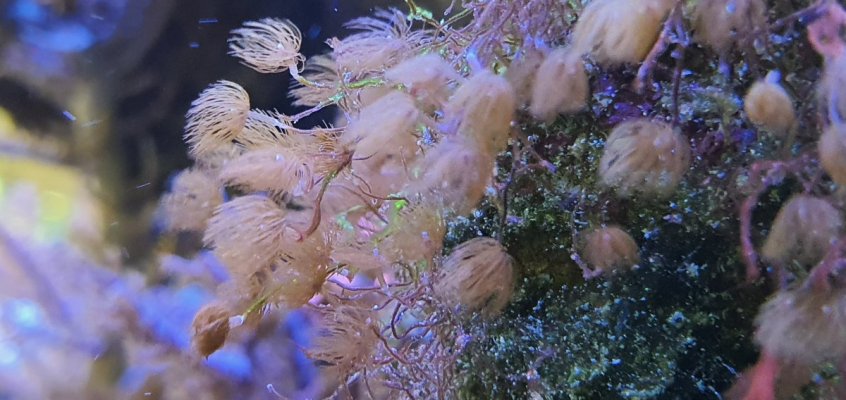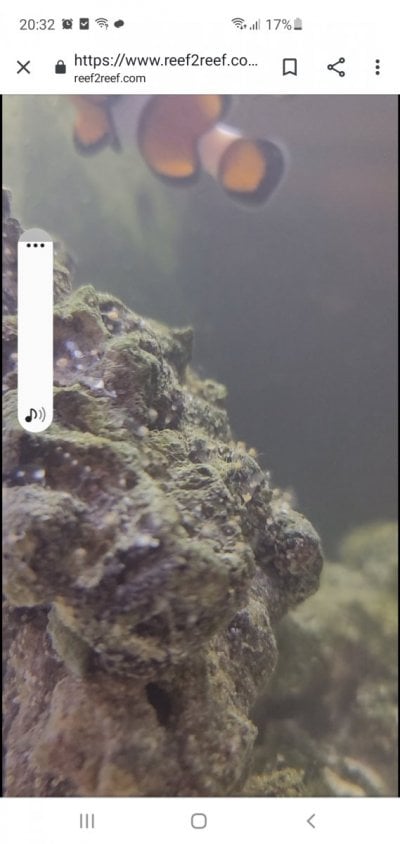- Joined
- Jul 8, 2019
- Messages
- 33
- Reaction score
- 52
Like many of us, I have had problems on and off over the years with Hydroids. The ones that have always given me the most problems are the common ones that almost look like a smaller and darker version of the beginner coral called Yellow Polyps. But the colonial Hydroid is much smaller than the yellow polyp and glows slightly greenish under blue light. In the past they never got to the point of hurting corals, but more recently they've been proliferating unchecked. So I decided to revisit the basic list of solutions as it appears that there's been no real consensus as what if anything can be done about this. Many have gotten desperate enough to NUKE their tank with a worming agent commonly used in dogs containing Fipronel. Given the porosity of live rock of good quality, once you put a heavy chemical like that in the tank....there will be trace amounts for a long, long time.
A) Lets discuss Fipronel. Its not a bad choice if you don't have a lot of corals and inverts. Many inverts can and do survive treatment...but its hit and miss. Fish can handle it well enough. All worms will die and rot in your rocks...its a wormicide. Its not a very practical solution someone with thousands of dollars of coral at risk. This is why its mainly used in seahorse tanks.
B) Butterfly fish....seems like about a 10% chance of success, but any fish that eats hydroids...might also eat your corals. Plus you would need to quarantine this fish for months to make sure of no Marine Velvet....which is the Black Death in a marine tank where no chemicals can be used and no fish can be caught in net due to coral hiding places. You cant put them in a hospital tank if you cant catch them and traps are often too big to work well in reef tanks.
c) Nudibranchs. Yes...we all know that a Lynx Nudibranch could very well solve this problem....good luck finding one of those! Its impossible. But you can use a common Sea Hare...probably 50% chance of success. There is a lot of wrong information suggesting that these can nuke your tank with ink. However the ones commonly sold by live aquaria and the like don't really have much toxic potential. Maybe a big one would wipe out a ten gallon. But in your large tank its a reasonably safe risk...especially if you have carbon reactor. You will need to provide supplemental algae as these Hares are easily starved.
D) Peppermint shrimp and Emerald Crabs...some eat hydroids and some don't. But I have definitely seen both species consume hydroids. Peppermint shrimp can also eat corals when they run out of hydroids and Aiptasia. but shrimp are easily trapped in a trap you make from a half liter water plastic bottle.
E) Husbandry. For many of us, Hydroids only beomce a problem once we start feeding corals. Most corals get by well enough on sunlight..but feeding makes them thrive. However the same food also makes Hydroid populations explode. Many experts think that one reason you don't want to Nuke your tank to get rid of Hydroids is that they are universally present in virtually every rock, snail, coral, etc we put in our tanks in some hidden unseen form. And they only become a problem once something gets out of balance or some factor triggers things to be favorable to hydroid growth...its not fully understood. So less coral feedings, better filtration--roller filtration is ideal...and possibly even UV sterilizer to knock down free floating life stages of various hydroids.
F) Sometimes increasing Alkalinity and Calcium will somehow make it unfavorable to Hydroids.
Personally, I've found over the years that every fish and shrimp even is as unique as a person....its really interesting but the same species of shrimp you will find ones that hate Aiptasia and the ones that love it. They are just individuals with individual preferences. This is why there is so much confusion over what reef additions will and will not solve your pest problems. Its like throwing a pizza part for kids...some kids won't eat pizza. To get around this...I always add 6 pep shrimps instead of 1 even if its overkill...same with emerald crabs. Eventually every population has an individual with the dietary preferences you require to fix your infestation. For my 100 gallon I added ten crabs and ten shrimp, one sea hare, I increase Alkalinity, I added a UV sterilizer, stopped feeding coral frenzy, installed a roller filter (keeps tank so clean skimmer produces nothing anymore). I don't think this eliminated Hydroids...but my tank went from hundreds to seeing almost none in a month. I'm sure they will come back...just like bubble algae and aiptasia generally find there way back in every few years. Most of the information contained in my article is already in previous posts...I just thought I'd save someone the 2 hours I spend once every few years researching Hydroids...its tough to research as they are one of the most diverse marine organisms on the planet...thus you might have ones that look the same as mine but are not the same at all.
A) Lets discuss Fipronel. Its not a bad choice if you don't have a lot of corals and inverts. Many inverts can and do survive treatment...but its hit and miss. Fish can handle it well enough. All worms will die and rot in your rocks...its a wormicide. Its not a very practical solution someone with thousands of dollars of coral at risk. This is why its mainly used in seahorse tanks.
B) Butterfly fish....seems like about a 10% chance of success, but any fish that eats hydroids...might also eat your corals. Plus you would need to quarantine this fish for months to make sure of no Marine Velvet....which is the Black Death in a marine tank where no chemicals can be used and no fish can be caught in net due to coral hiding places. You cant put them in a hospital tank if you cant catch them and traps are often too big to work well in reef tanks.
c) Nudibranchs. Yes...we all know that a Lynx Nudibranch could very well solve this problem....good luck finding one of those! Its impossible. But you can use a common Sea Hare...probably 50% chance of success. There is a lot of wrong information suggesting that these can nuke your tank with ink. However the ones commonly sold by live aquaria and the like don't really have much toxic potential. Maybe a big one would wipe out a ten gallon. But in your large tank its a reasonably safe risk...especially if you have carbon reactor. You will need to provide supplemental algae as these Hares are easily starved.
D) Peppermint shrimp and Emerald Crabs...some eat hydroids and some don't. But I have definitely seen both species consume hydroids. Peppermint shrimp can also eat corals when they run out of hydroids and Aiptasia. but shrimp are easily trapped in a trap you make from a half liter water plastic bottle.
E) Husbandry. For many of us, Hydroids only beomce a problem once we start feeding corals. Most corals get by well enough on sunlight..but feeding makes them thrive. However the same food also makes Hydroid populations explode. Many experts think that one reason you don't want to Nuke your tank to get rid of Hydroids is that they are universally present in virtually every rock, snail, coral, etc we put in our tanks in some hidden unseen form. And they only become a problem once something gets out of balance or some factor triggers things to be favorable to hydroid growth...its not fully understood. So less coral feedings, better filtration--roller filtration is ideal...and possibly even UV sterilizer to knock down free floating life stages of various hydroids.
F) Sometimes increasing Alkalinity and Calcium will somehow make it unfavorable to Hydroids.
Personally, I've found over the years that every fish and shrimp even is as unique as a person....its really interesting but the same species of shrimp you will find ones that hate Aiptasia and the ones that love it. They are just individuals with individual preferences. This is why there is so much confusion over what reef additions will and will not solve your pest problems. Its like throwing a pizza part for kids...some kids won't eat pizza. To get around this...I always add 6 pep shrimps instead of 1 even if its overkill...same with emerald crabs. Eventually every population has an individual with the dietary preferences you require to fix your infestation. For my 100 gallon I added ten crabs and ten shrimp, one sea hare, I increase Alkalinity, I added a UV sterilizer, stopped feeding coral frenzy, installed a roller filter (keeps tank so clean skimmer produces nothing anymore). I don't think this eliminated Hydroids...but my tank went from hundreds to seeing almost none in a month. I'm sure they will come back...just like bubble algae and aiptasia generally find there way back in every few years. Most of the information contained in my article is already in previous posts...I just thought I'd save someone the 2 hours I spend once every few years researching Hydroids...its tough to research as they are one of the most diverse marine organisms on the planet...thus you might have ones that look the same as mine but are not the same at all.





















